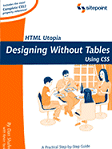Books @ HTML Source
HTML Utopia: Designing Without Tables: Using CSSHTML Source ReviewUsing Cascading StyleSheet properties to define the layout of your webpages by positioning elements precisely and being able to set the margins, padding and colours of all elements independently is the current vogue in web design. Stripping your designs of tables and writing lean HTML code offers many benefits — not least faster load-times and greater accessibility. Designing Without Tables: Using CSS takes you through the creative process of thinking in
The title of this book doesn’t tell the full story — it covers much more than just designing CSS layouts in place of old-style tabled layouts. Every aspect of writing CSS is covered. It starts out with a thorough introduction to CSS, which would serve well as a beginner’s tutorial, and defines all of the basics of writing CSS rules and linking your sheets to your pages. Soon after you’re given an in-depth run-through of the various typographic effects and display tricks that can be achieved so easily with the right code. Dan’s writing style is at once friendly and informative, and each area is given the appropriate level of detail. Everything is clear and practical. The book’s excellent reference section is ridiculously comprehensive — covering each and every CSS2 property in existence, along with examples, values and their browser support. It even covers the proprietary properties you’ll find in Mozilla (though honestly they should be left apart from the standard properties). It’s a superb reference, and adds a lot of value to the book as a whole. Even if you already know your stuff CSS-wise, the reference section alone is invaluable. I keep it on my desk at all times. As a side-note, SitePoint’s delivery system is one of the fastest I’ve ever seen — they shipped the book internationally to me within three days. That’s fast. In summary, highly recommended. —Ross Shannon Where you can get itYou can read four sample chapters of this book online for free. More details on Designing Without Tables: Using CSS at SitePoint’s site, or order it direct to your door. |
|
